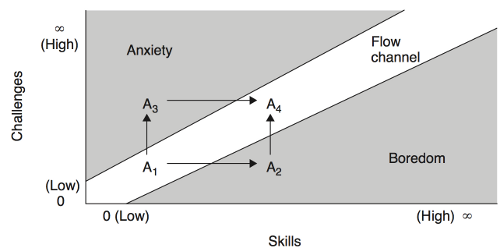Anxiety
How Can I Accelerate My Personal Growth?
Here's why you should get in over your head and figure it out as you go.
Posted September 8, 2014
In order to grow faster, you have to simply "dive in" more often.
In other words, you should choose "anxiety-driven growth" over "boredom-driven growth".
To understand this better, let's look at Jesse Schell's elaboration on Mihaly Csikszentmihalyi’s flow diagram:

For Csikszentmihalyi, flow is a magical zone between anxiety and boredom. Here's how to interpret the chart:
- The vertical axis represents the size of the challenges we are facing.
- The horizontal axis represents the power of our skills in relation to those challenges.
- When our challenges exceed our skills (in the upper left part of the diagram), we feel anxiety.
- When our skills exceed our challenge (in the lower right part of the diagram), we feel boredom.
- When our skills and challenges are closely matched (the diagonal zone from lower left to upper right), we are in a sweet spot where we feel neither too much anxiety nor too much boredom.
Csikszentmihalyi calls this diagonal channel the “flow channel”.
Flow is what we feel when we take on challenges that are well matched to our skills. That doesn’t mean the challenges are “easy” relative to our skills. In fact, Csikszentmihalyi says that to feel fully engaged, we must stretch ourselves a bit beyond our current comfort level – but not so much that we feel helpless or completely disoriented.
The Relationship Between Flow and Growth
Schell’s directed graph allows us to talk about the relationship between flow and growth.
A4 is a better place to be than A1. At A4 we are working on bigger challenges than at A1, and we have more skills to meet those challenges.
And notice that there are two ways to get from A1 to A4.
First, you can move from A1 to A2, and then to A4. On this path, you develop new skills without much challenge. And once you start to feel competent with those new skills, and you start to get bored with the way you are using those skills, you can take on a challenge that will use those skills and get your mind back in the game.
This might be the approach of a math student who keeps working on easy problem sets until he gets so good at them that he’s bored, and then decides to tackle a harder problem set.
Second, you can move from A1 to A3, and then to A4. On this path you take on a challenge before you have the skills to meet the challenge. This creates anxiety, and the anxiety drives you to develop the skills you need to meet the challenge.
This might be the approach of a math student who jumps right to the most difficult problem set and fills in her skills as she works on those problems.
We can call the first path “boredom-driven growth” (which is actually boredom-driven challenge acceptance).
And we can call the second path “anxiety-driven growth” (which is actually anxiety-driven skill acquisition.)
Choose Anxiety-Driven Growth
Of course there is a limit to how far out of your comfort-zone you should go. You still need to be somewhat realistic. You shouldn't bet your whole career, for instance, on completing a project that's way above your abilities in too little time.
And the amount of challenge-related anxiety you can stand will depend on how many other sources of stress you have in your life at the time. There will definitely be times in your life when you need to slow down and rest up.
But, within reason, anxiety-driven growth will help you grow faster than boredom-driven growth. That's because we tend to waste time when we take a "skills first" approach. We will over-learn skills out of context and then still have to learn how to make them work in-context when the time comes.
The mild positive anxiety will also focus our minds and help us choose the most relevant skills to focus on first.
So avoid the temptation to master all the skills you need before taking on a challenge.
Whenever you can, as long as the water's not too far over your head, just jump in, and figure it out as you go.
For a little longer answer, read this: To Flow, Or Not To Flow?


